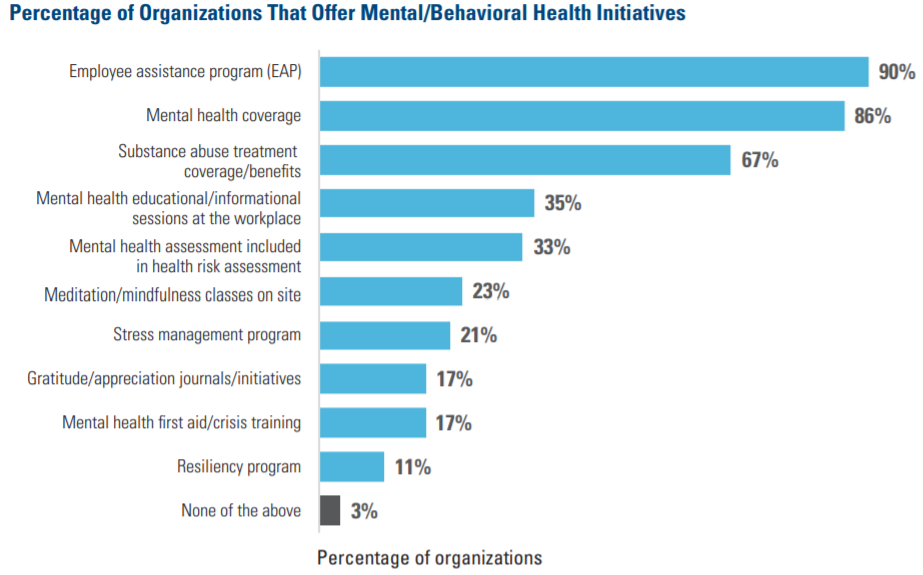Employers Enhance Emotional and Mental Health Benefits for 2020
Open enrollment is prime time to highlight the value of these programs

During the fall open-enrollment season, many employees will find that their companies have spruced up their well-being benefits, such as by offering programs that help workers monitor and reduce their stress levels, providing apps to support sleep and relaxation, and holding workshops on emotional resilience. Addressing employees' emotional health and well-being can also mean providing onsite yoga, meditation and mindfulness sessions. Quiet rooms at work also are now more common.
Further, employers are increasingly using telehealth programs to offer mental health counseling and being more generous with counseling sessions available through employee assistance programs (EAPs), which some are now calling "emotional assistance programs."
An Open-Enrollment Opportunity
"Employers are incorporating more communication on mental health benefits during open enrollment" to address mental health issues that affect work performance, such as anxiety and depression, said Clark Kays, director of partner marketing at Jellyvision, a Chicago-based benefits communications software firm. "Open enrollment is the time when employees can think of their mental health needs for the upcoming year, just as they think about their physical health needs," he added.
Nearly 86 percent of employees report improved work performance and lower rates of absenteeism after receiving treatment for depression, according to an April 2018 article in the Journal of Occupational and Environmental Medicine. This means "big gains in retention and productivity for employers," Kays said.
Jellyvision takes this message to heart and offers its employees supportive benefits "such as an emotional assistance program that includes unlimited phone sessions with a mental health professional, as well as in-person counseling," Kays noted.
And the firm is not alone in doing so. More employers are adopting a broad approach to mental health, according to the 24th annual Best Practices in Health Care Employer Survey by consultancy Willis Towers Watson.
The survey, which was completed by 610 large U.S. employers in July, found that:
- The number of employers measuring the stress level of their employees is on track to more than triple by 2021, from 16 percent to 53 percent.
- More than half of the employers polled (53 percent) will offer apps to support sleep and relaxation by 2021, up from the 27 percent who now do.
Addressing stress and anxiety early on can prevent costly treatment for physical conditions such as hypertension and diabetes. "Employers are making a small financial investment to keep costs low down the road," said Regina Ihrke, Minneapolis-based senior director and co-leader for integrated well-being at Willis Towers Watson.
Well-Being Apps Appreciated
"Not only are mental health benefits becoming more popular, we're seeing increased demand for them from both jobseekers and employees," said Misty Guinn, director of benefits and wellness at Benefitfocus, a cloud-based benefits management platform firm based in Charleston, S.C. "More employers are offering digital mental health solutions as true benefits, not perks, by offering them as fully paid or subsidized access to a variety of digital mental health applications," she noted.
Benefitfocus, for example, offers Happify—a mood training mental health app that teaches resiliency through gamification—on its BenefitsPlace platform. Other popular relaxation and meditation apps include Calm and Headspace.
"Millennials are used to quick tips and videos, so [apps] can be a great supplement to other mental health resources by offering fun, engaging guides on how to shift your mindset," Guinn noted. Also, that they can be used anonymously can make them appealing to users.
She added, "While these apps shouldn’t replace therapy or treatment, I see them as an innovative solution to supplement mental health care benefits."
Overcoming Burnout at Work
Despite the growing prevalence of well-being benefits, more than a quarter of U.S. employees (27 percent) would like their employer to provide additional support for mental health, including help coping with burnout, according to a survey of more than 2,200 employees conducted late last year by the nonprofit National Business Group on Health (NBGH) in Washington, D.C.
Burnout occurs when chronic, enhanced workplace stress isn't properly managed and leads to exhaustion, negative feelings towards the job, and reduced productivity and professional efficiency. A survey with more than 11,000 responses across the consulting, accounting, advertising and teaching industries by Fishbowl, a social networking app for professionals, found that 58 percent of employees in these fields said they suffer from job burnout.
NBGH's Health Workplace Well-Being and the Employee Experience survey found that 2 in 5 employees want help with burnout at work specifically, while roughly a quarter would like help so they can sleep better and become more resilient.
"Employees are looking to their employer to provide support on all areas of well-being—not just physical health programs focused on losing weight or understanding health risks, but those designed to help employees meet their financial, mental, community and social health goals," said NBGH President and CEO Brian Marcotte.
[SHRM members-only toolkit: Designing and Managing Wellness Programs]
Adding Value to EAPs
EAPs offer confidential assessments and services to help employees resolve personal or work-related problems that may affect job performance, along with mental and emotional health issues, said Cara McNulty, president of Aetna Behavioral Health in Minneapolis, which provides mental health services nationwide. However, "they can go much further to address the well-being of employees."
To improve the effectiveness of well-being benefits, "organizations are looking at EAP potential with a fresh set of eyes," said Dale Grenolds, the executive vice president at EAP provider ComPsych in Chicago.
In the past, he said, employers most often contracted with an EAP to give employees two to three sessions with a counselor. "Today, it's more likely that employers provide eight to 10 sessions involving a wider range of work/life support, from housing and relocation issues—including locating emergency shelters—to child care and elder care needs or legal and bereavement support when a loved one dies."
Managers could be more active in promoting EAP resources, McNulty advised. "An easy way to begin these conversations is to talk about stress causing a lack of sleep," she suggested. "From there, managers can point employees to available EAPs" that offer help with stress reduction and mental health concerns.
McNulty predicts EAPs will be used more in the years to come as cultural attitudes change and more Millennials join the workforce. "This generation is more open about mental health struggles than previous generations," she said, "making them more likely to leverage employee offerings like EAPs to address their mental health needs."
Telehealth Counseling
EAPs, like other benefits, are now app-accessible, allowing participants to interact with counselors online, including by texting. However, "many people still like to pick up a phone and talk to a clinician," Grenolds said.
Telehealth services providers are also making therapy sessions—via phone or video conferencing with psychologists and other mental health professionals—available as part of their programs.
"One of the goals of telehealth resources is to remove the barriers of getting help by putting the help right in the palm of someone’s hand," Guinn said.
Mental Health Coverage
"More organizations are making strides to provide better support systems for employees facing mental health challenges," said Julie Stich, CEBS, vice president of content at the International Foundation of Employee Benefit Plans (IFEBP), an employers group based in Brookfield, Wis. "Increased programs and options equate to higher costs, but for most organizations, it's worth the trade-off for a healthier, safer and more productive workforce."
The Workplace Wellness Trends survey report detailing IFEBP's findings of its survey conducted in May and June noted that among the 619 U.S. organizations polled:
Source: Workplace Wellness Trends report, International Foundation of Employee Benefit Plans.
Most organizations (68 percent) planned to increase their emphasis on mental health offerings over the next two years, the IFEBP survey showed.
Take advantage of open enrollment to "get employees excited about the resources they have at their fingertips to meet mental health goals," McNulty advised—but also continue to communicate the value of these benefits year-round.
Related SHRM Article:
Using Voluntary Benefits to Support Workforce Strategy, SHRM Online, February 2019
An organization run by AI is not a futuristic concept. Such technology is already a part of many workplaces and will continue to shape the labor market and HR. Here's how employers and employees can successfully manage generative AI and other AI-powered systems.




